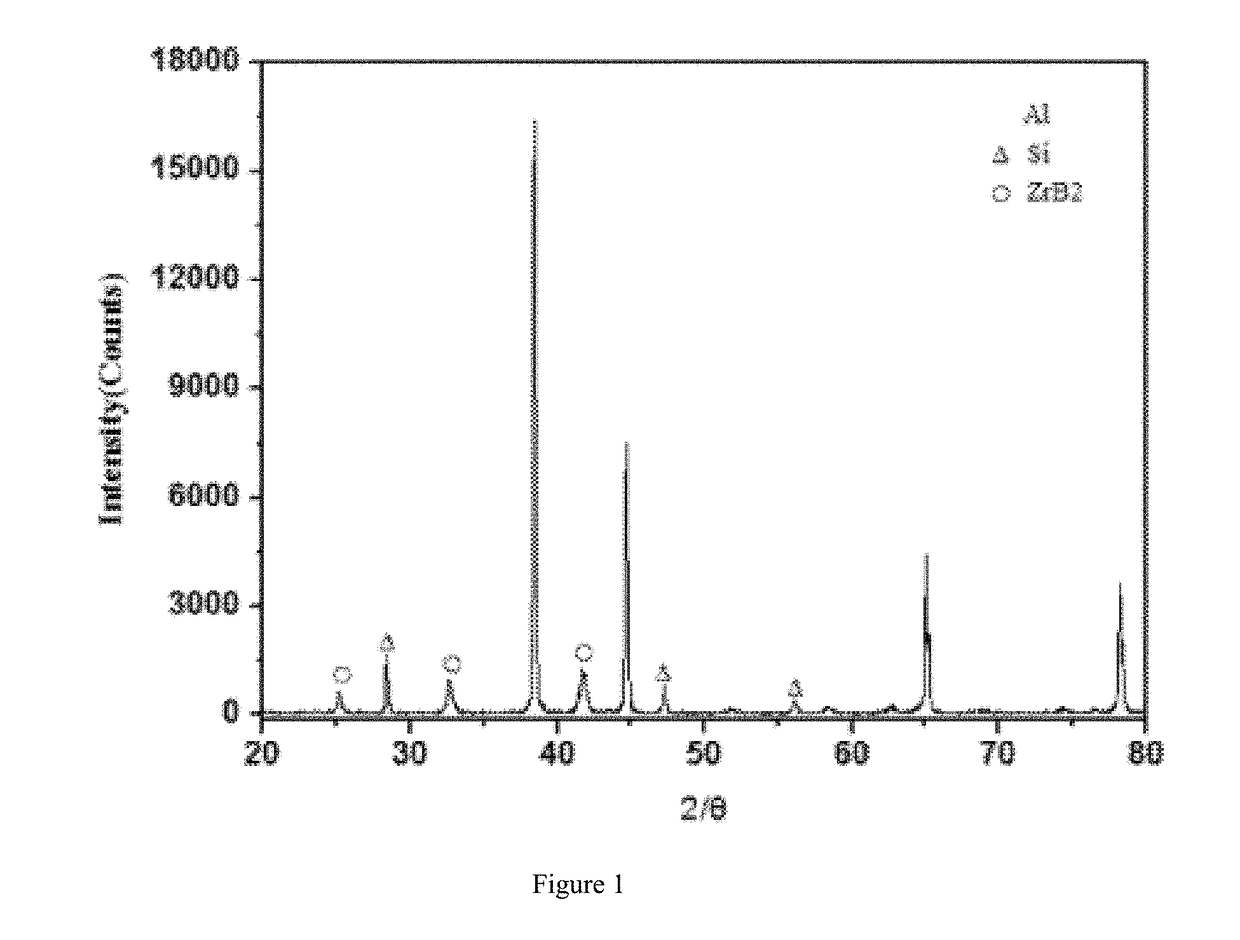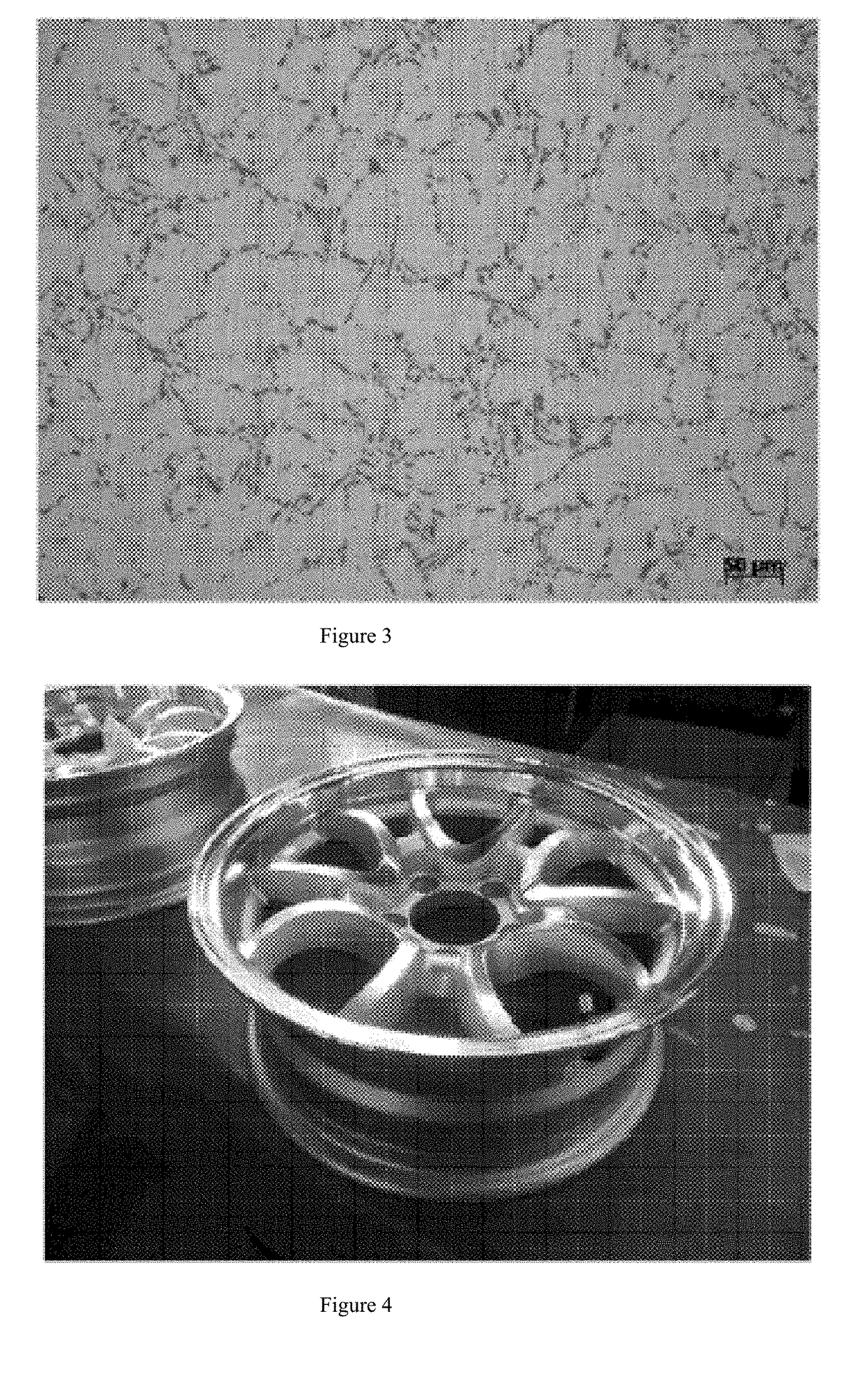Anti-fatigue in-situ aluminum-based composite material for heavy-load hubs and preparation method therefor
a technology of aluminum hubs and composite materials, which is applied in the direction of hubs, transportation and packaging, material nanotechnology, etc., can solve the problems of fatigue cracks and breakage, a356.2 alloy materials extensively used by aluminum hubs for automobiles, and cannot meet the requirements of higher strength and fatigue life of heavy-duty automobiles, so as to improve strength, toughness and anti-fatigue performance, the effect of increasing the modulus and fatigue li
- Summary
- Abstract
- Description
- Claims
- Application Information
AI Technical Summary
Benefits of technology
Problems solved by technology
Method used
Image
Examples
example 1
[0026]Taking Al-15Zr, Al-20Er, Al-20Y, Al-20Cr, Al-10Mn and Al-10B intermediate alloy and A356.2 alloy as raw materials, the A356.2-X composite material hub is prepared via pressurized gravity casting rapid sequential solidification molding technology.
[0027]Transferring the molten 500 Kg commercial A356.2 alloy (750-760° C.) is transferred into insulated degassing tundish, and putting the graphite rotor in reversing rotation, into which argon can be introduced, into the tundish for refining and degassing for 5min; scattering a layer of covering agent uniformly on the surface of the alloy melt of the tundish, after the covering agent is scattered uniformly on the surface layer of alloy and forms a protective film, pressing the weighed Al-15Zr, Al-20Er, Al-20Y, Al-20Cr and Al-10Mn intermediate alloy into the alloy melt by the graphite immersion bell through the covering agent, making the graphite rotor rotate reversely for 15 min to promote the fast melting and uniform scattering of t...
example 2
[0029]Taking Al-15Zr, Al-20Er, Al-20Y, Al-20Cr and Al-10Mn intermediate alloy, KBF4 and A356.2 alloy as raw materials, the A356.2-X composite material hub is prepared via the pressurized gravity casting rapid sequential solidification molding technology.
[0030]Using Al-15Zr, Al-20Er, Al-20Y, Al-20Cr and Al-10Mn intermediate alloy for introduction of microalloying element, firstly, adjusting the mass percent of the elements in alloy as follows: Zr 4.5, Er 0.25, Y 0.18, Cr 0.22, Mn 0.12 (the specific steps are the same as those of the example 1); pressing the weighed KBF4 into the melt using immersion bell and stirring by the graphite rotor for 10 min, making B element (the content is 0.89 wt. % of A356.2-X composite material hub) in-situ react with the Zr element uniformly dispersed in the melt to synthesize the uniformly dispersed nano-ZrB2 ceramic reinforcement; removing the graphite stirring rotor, stopping heat preservation and heating, cooling the composite melt to 720-730° C., r...
example 3
[0032]Taking Al-15Zr, Al-15Er, Al-10Y, Al-5Cr and Al-10Mn intermediate alloy, KBF4, and A356.2 alloy as raw materials, the A356.2-X composite material hub is prepared via the pressurized gravity casting rapid sequential solidification molding technology.
[0033]Using Al-15Zr, Al-15Er, Al-10Y, Al-5Cr and Al-10Mn intermediate alloy for introduction of microalloying element, firstly, adjusting the mass percent of the elements in alloy as follows: Zr 4.0, Er 0.2, Y 0.25, Cr 0.18, Mn 0.1 (the specific steps are the same as those of the example 1); pressing the weighed KBF4 into the melt using immersion bell and stirring by the graphite rotor for 10 min, making B element (the content is 0.77 wt. % of A356.2-X composite material hub) in-situ react with the Zr element uniformly dispersed in the melt to synthesize the uniformly dispersed nano-ZrB2 ceramic reinforcement; removing the graphite stirring rotor, stopping heat preservation and heating, cooling the composite melt to 720-730° C., remo...
PUM
| Property | Measurement | Unit |
|---|---|---|
| size | aaaaa | aaaaa |
| temperature | aaaaa | aaaaa |
| pressure | aaaaa | aaaaa |
Abstract
Description
Claims
Application Information
 Login to View More
Login to View More - R&D
- Intellectual Property
- Life Sciences
- Materials
- Tech Scout
- Unparalleled Data Quality
- Higher Quality Content
- 60% Fewer Hallucinations
Browse by: Latest US Patents, China's latest patents, Technical Efficacy Thesaurus, Application Domain, Technology Topic, Popular Technical Reports.
© 2025 PatSnap. All rights reserved.Legal|Privacy policy|Modern Slavery Act Transparency Statement|Sitemap|About US| Contact US: help@patsnap.com



